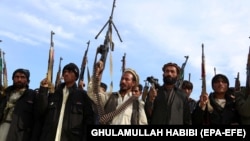Officials and residents in eastern Afghanistan say clashes between the hard-line Afghan Taliban and the ultra-radical Islamic State (IS) have continued for a second day.
Abdul Ghani Musamim, spokesman for the governor of eastern Kunar Province, confirmed ongoing fighting between the two Islamist organizations in the Deegal area of Kunar’s remote Chapa Dara district.
“We can confirm the fighting but cannot say anything about casualties because we have not received any information from officials in the region,” he told Radio Free Afghanistan on June 27. “We are hearing some claims about casualties and that both sides have captured each other’s fighters.”
A Deegal resident who requested anonymity because of fear of persecution by the militants told Radio Free Afghanistan that the fighting began in the early hours of June 26.
“There was intense fighting yesterday, and there is still sporadic shooting,” he said. “We are hearing that Daesh (local name for IS) has captured 10 Taliban fighters while the Taliban have captured five IS militants.”
He says the fighting has disrupted civilian life as residents are staying indoors to avoid getting caught in the crossfire.
“Previously, government troops were fighting against IS militants so the insurgents mostly targeted government compounds,” he said. “The fighting now is widespread, and Deegal residents are extremely anxious.”
The Afghan National Army’s 201st Silab Corps also confirmed the clashes in Chapa Dara. Its June 27 statement claimed four IS militants were killed in the fighting while nine more were captured by the Taliban. The statement said that the IS militants also captured two Taliban fighters.
It was not possible to reach the warring sides. Neither the Taliban nor IS have commented on the clashes. While the Taliban are typically vocal about publicizing combat with Afghan and international troops, statements about fighting other militant groups are rare. IS, on the other hand, mostly announces claims for major attacks that typically target Afghan civilians.
The two sides have frequently clashed across Afghanistan, particularly in Kunar and the neighboring provinces of Nangarhar and Nuristan, where the main IS organization first emerged in 2015.
On June 25, Attaullah Khogyani, a spokesman for the provincial governor, said eight IS fighters were killed and three more captured after they clashed with pro-government volunteers in the Nazian district late on June 24. He told Radio Free Afghanistan that two pro-government volunteers, locally known as uprising forces, were killed and two more were injured in the clash.
Despite large-scale Afghan and international military operations, systemic targeting of leaders, and frequent clashes with the Taliban, IS remains a formidable force in the mountainous region, which borders Pakistan’s northwestern Khyber Pakhtunkhwa Province.
But John Nicholson, commander of U.S. and NATO forces in Afghanistan, is adamant that Afghan and international troops have made substantial progress against IS.
“Today, we are here talking to you about the elimination of Daesh; it is a place which Daesh wanted to convert into Khurasan,” he was quoted as telling journalists in Nangarhar’s capital, Jalalabad, on June 24.
Afghan officials and the Taliban suspect IS was behind two suicide attacks that killed more than 50 people in Nangarhar on June 16 and 17, when Afghans celebrated a three-day truce to mark the Islamic holiday of Eid al-Fitr.
IS claimed claimed responsibility for the June 16 attack, which killed at least 36 people including members of the Afghan armed forces and the Taliban.
IS in Afghanistan is mostly made up of Pakistani, Afghan, and Central Asian fighters previously associated with Afghan and Pakistan Taliban factions and the Islamic Movement of Uzbekistan.
IS’s emergence prompted the late Taliban chief Mullah Akhtar Muhammad Mansur to warn IS leader Abu Bakar Al-Baghdadi. In a June 2015 letter, Mansur wrote that they would be “forced to react to defend our achievements” if IS were to encourage a new jihadist front in Afghanistan.
During the past three years, militants from the two groups have engaged in sporadic battles and a covert assassination campaign that has extended into Pakistan.








